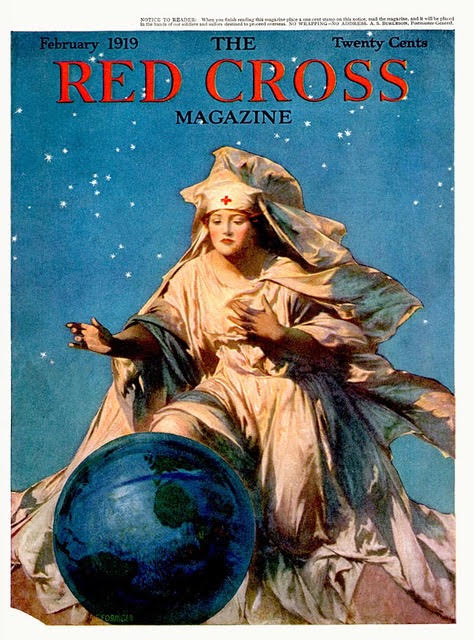
The
Formation of The Miami County Chapter of the American Red Cross
“The
American Red Cross is the
development of the idea in the mind of a noblewoman that loving one’s
neighbor
means helping him in time of trouble and relieving or decreasing his
suffering
and pain in sickness, accident or misfortune.”
~ Peru Journal 4/24/1917
It is mid-July of 1917 and a large
crowd
swarms the lawn on the West side of the Miami County, Indiana
Courthouse. Broadway is jammed with
traffic and
impassable. It is evening. Girls walk among the crowd dressed in Red
Cross uniforms. They are gathering free
will offerings from the assembled crowd. The
entertainment for this first fundraiser of the local
Red Cross is
the daredevil Billie Mars who is also known as “The Human Fly”. He is going to scale up the side of the Court
House. Large searchlights are shining on
the side of the building where he will perform the stunt.
Excitement ripples through the crowd as they
wait for the 8 pm climb to begin. Some saw
him earlier in the day when he scaled up the side of the First Baptist
Church
but this evening’s crowd is much larger and hundreds of people are
present. The event will raise one
hundred much-needed dollars for the war work of the local Red Cross. What follows is an explanation of that work
during the First World War at the national and local level including
short
biographies of the people who were responsible for the formation of the
Miami
County Chapter of the American Red Cross.
- Charles Gillette Burton
- Nona M. O’Brien Cathcart
- Bessie Labonte Cole
- Georgia Bearss Crume
- Richard Arthur Edwards and Alice Shirk Edwards
- Dora Kraus Gunzburger
- William Adelbert Hammond
- Omer Holman
- Sarah Baer Levy
- Gertrude Thiebaud MacDuff
- Dr. Harry Nyce
- Joseph Henry Shirk and Helen Martha Royse Shirk
- Dr. George Van Mater
- Charlotte Strauszer Welch
Written and submitted by Mary Rohrer Dexter
Works Cited
“American Red Cross.” Social Welfare History Project, 26 Feb. 2018,
socialwelfare.library.vcu.edu/organizations/american-red-cross/.
“Big Crowd Sees Human Fly Here.” Peru Journal, 16 July 1917.
Cross.", "American Red. “American Red
Cross.” International Directory of
Company Histories, Encyclopedia.com, 2018,
www.encyclopedia.com/sports-and-everyday-life/social-organizations/private-organizations/american-red-cross.
“Donation To Red Cross.” Peru Republican, 30 Nov. 1917.
“Easing The Cares Of Soldiers' Families.” Unknown Newspaper, 1918. Annuals of
Miami County 1918 Binder
“Final Preparations Will Be Completed At Mass Meeting
Tuesday Night At Wallace Theater.” Peru
Journal, 19 June 1917.
“Golf Game Attracts Big Crowd.” Peru Journal, 11 July 1918.
“It's Very Simple Says Human Fly Of Scaling Brick Walls.” Peru Journal, 20 July 1918.
“IUPUI.” Indiana
Red Cross | University Library, ulib.iupui.edu/collections/IRC.
“Join Red Cross - Wilson.” Peru Republican, 21 Dec. 1917.
“Join The Red Cross This Week.” Peru Republican, 21 Dec. 1917.
Kelly, John. “Perspective | Remembering the Great
Things the Red Cross Did during the Great War.” The Washington Post,
WP Company, 5 Sept. 2017,
www.washingtonpost.com/local/remembering-the-great-things-the-red-cross-did-during-the-great-war/2017/09/05/4ad59d38-9248-11e7-8754-d478688d23b4_story.html?noredirect=on&utm_term=.18e0c0b7690e.
“Miami Red Cross Presents Drama.” Peru Republican, 7 Dec. 1917.
“Mississinewa Club.” Peru Journal, 2 July 1918.
“Noted Golf Players To Appear At Country Club In Match
For the Benefit of the Local Red Cross.” Peru
Journal, 9 July 1918.
“Noted Golfers Will Play Here.” Peru Journal, 29 June 1918.
“Open Letters to Citizens of Miami County From the
Committee of Red Crossers.” Peru Journal,
21 June 1917.
“Perry Township Red Cross.” Unknown Newspaper, Oct. 1918.
“Peru Is Ready For Exhibition.” Peru Journal, 9 July 1918.
“Peru Women Rescue A Hospital.” Indianapolis Star, 1 June 1913.
“Preserving Indiana's Historic Red Cross Connection.” Indiana Landmarks, 14 June 2017,
www.indianalandmarks.org/2017/06/preserving-indiana-historic-red-cross-connection/.
“President Has Changed Red Cross Arrangements.” Peru Journal, 19 May 1917.
“Red Cross And Patriotism.” Peru Republican, 19 Oct. 1917.
“Red Cross Commended.” Peru Republican, 9 Nov. 1917.
“Red Cross Lecture At The Wallace Theater.” The Sentinel, 20 Nov. 1918.
“Red Cross Membership.” Peru Republican, 28 Dec. 1917.
“Red Cross Society Developed From Idea of American
Woman.” Peru Journal, 24 Apr. 1917.
“The Red Cross Society In Time of Peace.” Peru Journal, 25 Apr. 1917.
“The Red Cross Society In Time of War.” Peru Journal, 26 Apr. 1917.
“Red Cross Supper.” The Sentinel, 21 Oct. 1918.
“Red Cross Timeline.” American Red Cross, www.redcross.org/about-us/who-we-are/history/significant-dates.
Rosenberg, Jennifer. “A Short History of the American
Red Cross.” ThoughtCo,
www.thoughtco.com/american-red-cross-1779784.
“Search Results from Posters: World War I Posters,
Nurses, American+Red+Cross.” The Library
of Congress,
www.loc.gov/collections/world-war-i-posters/?fa=subject%3Anurses%7Csubject%3Aamerican%2Bred%2Bcross.
“Tea For Red Cross.” Peru Republican, 14 Dec. 1917.
“These Champions Aid Red Cross With Golf Matches.” Peru Journal, 23 July 1918.
“To Climb Court House For Fund.” Peru Journal, 12 July 1917.
“To Whom It May Concern.” Peru Republican, 9 Nov. 1917.
“Uniformed Women Meet To Begin on War Work.” Peru Journal, 12 May 1917.
Unknown. “Page One and Page Nine.” The History of the Miami County Chapter of
the American Red Cross Peru Indiana, Self Published , pp. 1 and 9.
Watson, Susan. “A History of Service: The American Red
Cross During World War I.” Red Cross Chat,
15 June 2017,
redcrosschat.org/2017/04/10/history-service-american-red-cross-world-war/.
The Work of the
American Red Cross ARC during the Great War, Introduction and Table of Contents
| Medical Front WWI,
www.vlib.us/medical/ARC/ARCintro.htm.




